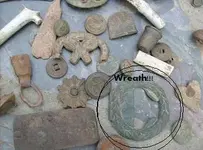tinpan
Silver Member
American Gold Miner's Buckle
Hi All
History Miner's Diary September 1852 Victoria Australia
"The three of us ,having agreed to combine for a trail of the Mt Alexander Diggings , we purchased a cradle ,large tent and tools, and provisions for two months, and gave a teamaster $20 to convey the lot to Fryer's Creek We tramped up with the waggon , making the trip in five days. On reaching Fryer's Creek we found that place crowded and gold being got in large quantities, but we fancied the good ground was all occupied, and, hearing that many were going to Cambell's Creek , we decided to head there .
The Hunt
I decided to try the large open flat above the creek where once numerous first gold rush camps once existed. Not a tree was left standing and every rock was turned over in the first rush . Over the next 160 years tons of clay and wash soil had been washed by the seasonal rain down onto the camp site . So all targets were to be found at depth, with also mineralised ground this the true element of the PI units . I have been using a GPX 4500 for last few years and had good days and bad days . The first gold miner's didn,t leave gold and this site was not the best field . One thing i will say over the past year, my partner and myself have found some of the best first gold mining relics and only little gold. With miner's from 28 countries there always something different to be found . Chinese , American , British, Hungarian, German and others .
This is one of 5 buckles found at this gold rush camp and as my post in What Is it" is the rarest
American California Miner's Buckle tinpan
tinpan
Hi All
History Miner's Diary September 1852 Victoria Australia
"The three of us ,having agreed to combine for a trail of the Mt Alexander Diggings , we purchased a cradle ,large tent and tools, and provisions for two months, and gave a teamaster $20 to convey the lot to Fryer's Creek We tramped up with the waggon , making the trip in five days. On reaching Fryer's Creek we found that place crowded and gold being got in large quantities, but we fancied the good ground was all occupied, and, hearing that many were going to Cambell's Creek , we decided to head there .
The Hunt
I decided to try the large open flat above the creek where once numerous first gold rush camps once existed. Not a tree was left standing and every rock was turned over in the first rush . Over the next 160 years tons of clay and wash soil had been washed by the seasonal rain down onto the camp site . So all targets were to be found at depth, with also mineralised ground this the true element of the PI units . I have been using a GPX 4500 for last few years and had good days and bad days . The first gold miner's didn,t leave gold and this site was not the best field . One thing i will say over the past year, my partner and myself have found some of the best first gold mining relics and only little gold. With miner's from 28 countries there always something different to be found . Chinese , American , British, Hungarian, German and others .
This is one of 5 buckles found at this gold rush camp and as my post in What Is it" is the rarest
American California Miner's Buckle
 tinpan
tinpanAttachments
Upvote
41














 ..you just can't keep us boys down.
..you just can't keep us boys down.
